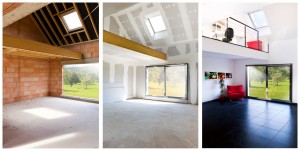S.M.A.R.T Project Objectives
|
|
When you know what project you want and why you want it we recommend a basic project management tool known as “SMART objectives” which can help deepen your understanding of your project.
Smart Project Objectives stand for…
- Specific – Don’t generalize about your project be specific who, what, where, when, which, why.
- Measurable – How is your project measured, how big/many, how will I know when it is progressing or finished.
- Attainable – Identify the aspects important to you then think how to make them attainable.
- Relevant – Your Project should be important and relevant to all stakeholders.
- Time bound – You should have a degree of urgency and a time frame.
Home Extensions Basic Specifications
- Home Extensions Conversions etc are not Painted/Decorated as Standard.
- Standard Electrics = 1 Light, 1 Switch,1 Double Socket/Room
- Standard Plumbing = One Radiator/Room.
- Plumbing Systems are not Upgraded as Standard.
- Electrical Systems are not Upgraded as Standard.
- External ground works include making good only to new Extension

full potential and abilities and maintaining safe environmentally friendly working practices.
Our Core Beliefs We intend to uphold common law, respect and engage constructively with all project stakeholders providing adequate information and dealing with any
issues within a fair and ethical method. To promote a safe and healthy site operating safe methods of working.
The 12 steps are: Define -> List the tasks -> Estimate -> Critical Path -> Accelerate -> GANTT CHART -> Resources -> Risk -> (START) -> Monitor Progress -> Money -> Reschedule ->
Review Terms & Conditions
[/vc_column_text][/vc_column]
Typical Critical Path Diagram Design & Budget Try to repeatedly identify, define and prioritize the objectives of your project. re-listing and redefining your objectives will deepen your understanding of the project and promote effective dialogue with your builder. Good communication is key, so know and be clear what you want and don’t want and why before you move into the design stage remembering that: Once you know what you want and why you want it, you can choose the size shape and roof type etc. enabling a ball park estimate to be given by most good builders. Once plans are drawn choose a builder with experience and references and make a contract based upon the approved plan. Agree the starting date and stage payments early on, after footings, after wall plate, after roof and after completion etc. Be very clear on what is included and what is not, especially with tiling, floor covering, finishing, decoration, making good gardens and driveways etc.
Design & Budget Try to repeatedly identify, define and prioritize the objectives of your project. re-listing and redefining your objectives will deepen your understanding of the project and promote effective dialogue with your builder. Good communication is key, so know and be clear what you want and don’t want and why before you move into the design stage remembering that: Once you know what you want and why you want it, you can choose the size shape and roof type etc. enabling a ball park estimate to be given by most good builders. Once plans are drawn choose a builder with experience and references and make a contract based upon the approved plan. Agree the starting date and stage payments early on, after footings, after wall plate, after roof and after completion etc. Be very clear on what is included and what is not, especially with tiling, floor covering, finishing, decoration, making good gardens and driveways etc.
The success of the project will be judged by its functionality in context with your original objectives and your actual needs.
My 3 Fundamental Design Rules are;
- Plenty of natural light.
- Plenty of thermal and acoustic insulation.
- Try to keep within budget
The information below should help you avoid some of possible headaches and hopefully give you a more rounded view of what you are getting yourself into when managing a Project on your home. If it’s your first time I sincerely hope this simple advice may help avoid some unnecessary stress. 
- Those who are genuinely inexperienced
- Those who want their foot in the door and access to your money at all costs and who will keep
- Asking.
- Promising.
- Apologizing.
These types of builders generally disappear without finishing the Job at a time of their choosing.
Preparation
Firstly – try to take a step back and try to look a little more formally and more objectively at your project, Try to think you are building the project for someone else and try to set out a strict management culture at an early stage while constantly highlighting and remembering your reasons for having it built.
| NI Planning Service Advice Building Control Guidance notes |
The Benefits of Natural Light
& its positive effect on building performance and human health.
Many say Architects have given us buildings and developments divorced from their context, like some alien realm disconnected from ecology … and place.” In cities today, daylight is one of the last ways we can reconnect with our inner most wild extinct s. Formally in the practice of architecture, day-lighting refers to the use of natural light,(brilliant or overcast) in supporting the visual demands of a buildings occupants using natural light as the primary source of daytime illumination to create a visually and thermally comfortable place connected to outdoor phenomena.
Three tasks that are critical to a successful day-lighting installation are:
- The control of direct sunlight at visual task areas during all occupied hours;
- The provision of balanced luminescence on interior surfaces, particularly between perimeter windows and key vertical surfaces within the interior volume;
Once a design is executed, ensure operational success by educating building occupants and operators on the intent of the day-lighting design, how to use lighting controls, and how to access and use shading controls. It is the “seasonal variability of interior daylight illumination,” Heschong says, “along with views to the outdoors that provides important stimulus to the circadian system, [and] along with making any space more pleasurable and interesting for its occupants.”




